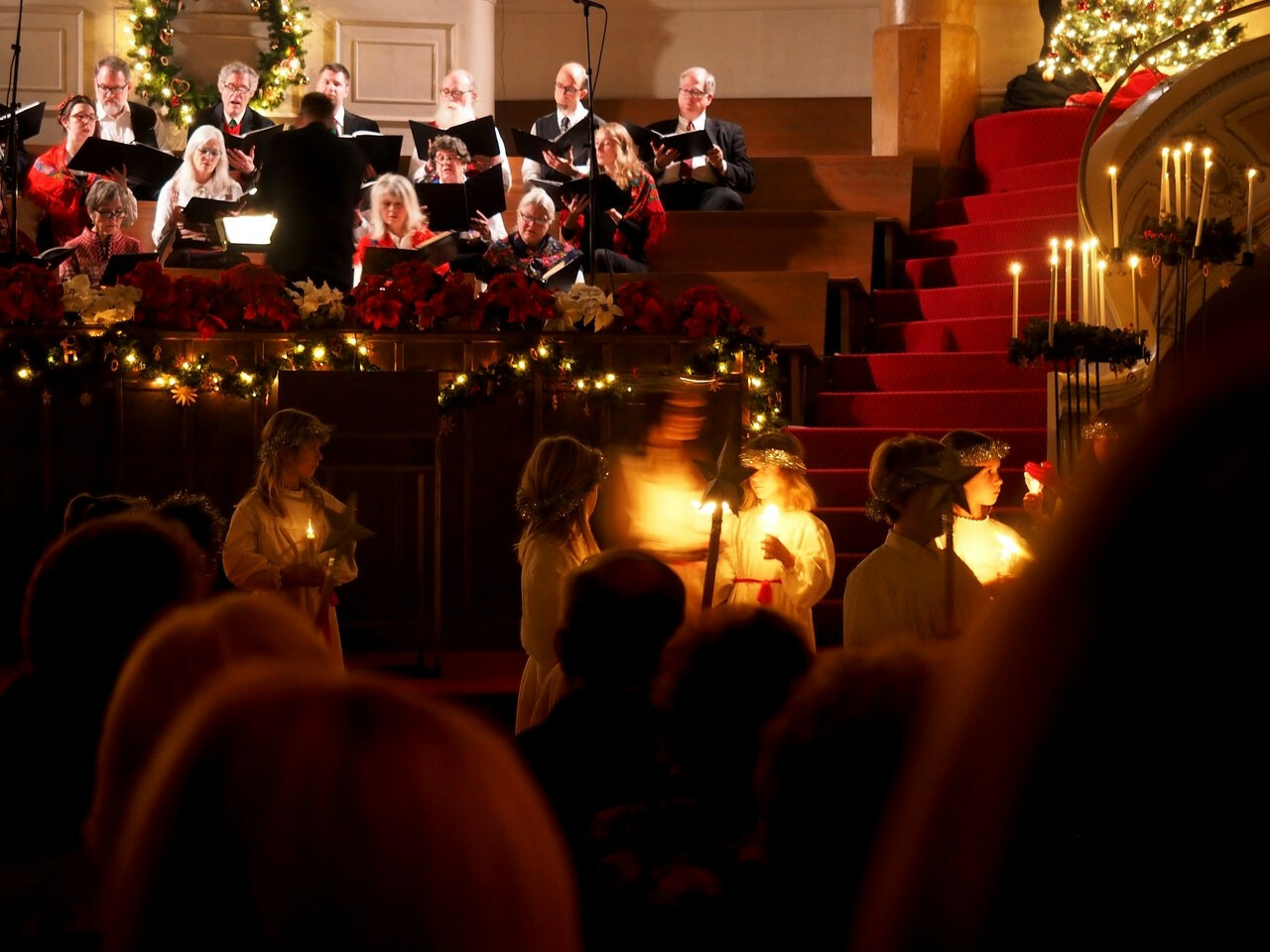Series: December 2018
Category: Advent - Love
Speaker: Bethany, RuthE., Rob, Jeff

Luke 1:46-55
And Mary said, “My soul magnifies the Lord, and my spirit rejoices in God my Savior, for God has looked with favor on the lowliness of his servant. Surely, from now on all generations will call me blessed; for the Mighty One has done great things for me, and holy is his name. God’s mercy is for those who fear her from generation to generation. God has shown strength with her arm; God has scattered the proud in the thoughts of their hearts. God has brought down the powerful from their thrones and lifted up the lowly; he has filled the hungry with good things and sent the rich away empty. God has helped her servant Israel, in remembrance of God’s mercy, according to the promise God made to our ancestors, to Abraham and to God’s descendants forever.”
Make a Joyful Noise
Bethany – “O Come, O Come, Emmanuel”
Although we did not make our lector sing this morning, this scripture passage was originally a song. Mary is so filled with joy and praise upon learning that she will give birth to this very special child named Jesus, she can’t help but burst into song. In this moment, spoken words just aren’t enough – she expresses her praise to God in song.
There is something about music, isn’t there? Music is so often able to move us in ways that nothing else can. I find that especially during the Advent and Christmas season, music is an essential part of my preparation for the Christ Child.
Today, we want to focus on some of the music of this season. We each have chosen a song that is meaningful for us, and we are going to share just a little bit about the song with you. Then, we will all get a chance to sing together.
The song I have chosen, “O Come, O Come, Emmanuel,” has roots in the ancient monastic tradition. Beginning as early as the 6th century, the priests would pray with scripture at designated times throughout the day and night … once every three hours. They would read a scripture passage and then sing an antiphon – a short sentence set to music intended to reinforce the meaning of the scripture passage.
During the final week of Advent, the tradition soon became to read the Magnificat (the song of Mary that we just heard) each night and sing one of the “O Antiphons.” There are seven “O Antiphons,” one for each night of the week. Each offers a different image of the coming Messiah, drawn from various scripture passages. Every O Antiphon begins with “O,” then a title for the coming Christ, and then a petition/a request.
For example, the “Wisdom” O Antiphon (one of the seven) says, “O Wisdom, O holy Word of God, you govern all creation with your strong yet tender care: Come and show your people the way to salvation.”
Each of the seven stanzas of “O Come, O Come, Emmanuel” is adapted from one of these O Antiphons that the monks would sing the week before Christmas. The man to adapt these into English from their original Latin was John Mason Neale. Neale lived in the mid-1800’s, saddened by the loss of some of the older Roman and Orthodox hymns as new hymnody began to proliferate. His passion was restoring pre-Reformation liturgy and music, and he devoted his life to translating hymns from Latin and Greek into English.
As we sing all seven verses of “O Come, O Come, Emmanuel,” take note of the seven different ways the hymn addresses the coming Christ. In addition, what is the petition that each verse is asking of the Messiah? Let us sing together.
RuthE. – “Before the Marvel of This Night”
I chose this hymn because I love the text, but before preparing for this sermon I had no idea how prolific the poet was.
Jaroslav Vajda [va-HEE-duh] (1919-2008) was one of the leading hymn writers in the twentieth century and the preeminent Lutheran hymn writer of his generation. He was born in Ohio, the son of a Lutheran pastor. He wrote his first hymn at age 49, followed by more than 225 original works and translations that now appear worldwide in more than 65 hymnals. Seven appear in our current hymnal, including one of my favorite communion hymns. You can look them up on page 998.
The music, of course, makes a significant contribution to the experience of this hymn, and in fact it is the unusual meter of Carl Schalk’s music that deepens the appeal of this hymn for me. Vajda and Schalk collaborated for 40 years and were jointly commissioned to write 26 hymns.
Vajda has been lauded as the poet laureate of the hymn world, and described his own work this way: “My hymns are … poetic expressions of thanks to God. They are my grateful reaction – my praise and wonder and exclamation – to the love and glory of God.”
That’s what comes shining through in this text that addresses the heavenly host of angels. There’s a phrase in the first verse that sort of puts me in mind of Emma Thompson’s angelic entrance in the HBO film adaptation of Angels in America, where Prior is dozing in his sick bed and hears the gentle instruction, “Look up.” When he doesn’t immediately respond, the voice repeats more insistently, “Look up.” With again no response, she suddenly amps up the presentation, “Look up!” And the ceiling caves in and she floats into his vision in diaphanous splendor saying, “Greetings, prophet! The great work begins!”
That’s sort of what I picture when Vajda says in the second line, “then tear the sky apart with light, and with your news the world endow.” Yet Schalk’s tender setting invites a more reverent and introspective approach. Before the marvel of this night, adoring fold your wings and bow; then tear the sky apart with light and with your news the world endow. Proclaim the birth of Christ and peace, that fear and death and sorrow cease: sing peace; sing gift of peace! Let’s sing it together.
Rob – “Lo, How a Rose E’re Blooming”
This German hymn, in the original, “Es ist ein Ros ensprungen,” first appeared at the end of the 16th century, though its text may date back to the century prior. You see but three verses in your hymnal, but as many as 23 stanzas have been associated with this hymn.
As the second verse alludes, the chief image of the rose is said to grow from prophecy in the 11th chapter of Isaiah:
A shoot shall come out from the stump of Jesse,
and a branch shall grow out of his roots.
The spirit of the Lord shall rest on him
the spirit of wisdom and understanding,
the spirit of counsel and might,
the spirit of knowledge and fear of the LORD
After more familiar imagery of a promised coming kingdom in which the wolf is found lying down with the lamb and the leopard and the kid, it continues:
On that day the root of Jesse shall stand as a signal to the peoples/nations.
You’ll notice, the “rose” specifically does not appear in the prophecy.
In the tradition, the rose has been a feminine symbol, most often associated with the Virgin Mary, and even with Eve who lived in the Garden of Eden, where legend has it there were roses that grew without thorns.
In our rendering, perhaps bearing the imprints of Protestantism, we behold the beauty of the rose alongside the Mother Mary. This rose is Jesus.
Paul Westermeyer writes that the tune “has the unusual capacity to lend itself equally well to both congregational and choral singing.” [1]
Lo, How a Rose E’er Blooming was the favorite Christmas hymn of my later father in law, The Rev. Edwin (Wynn) Hausser, who, God-willing, I will meet in the next life for the first time and to whom I dedicate it now.
Jeff – “Silent Night”
Generally speaking we dedicate an hour to worship Jesus Christ regardless of if its Christmas or not. We know that because of the looks on your faces if it has been one hour ten minutes. We also know by the looks on your faces if it was only forty-five minutes.
1,753,176 hours ago, which is
73,049 days ago, which actually is
200 years ago tomorrow
The song Silent Night was written. It was originally written as an upbeat tune but as happens to great art and pieces of culture, it gets reinterpreted to a different time. It was slowed down to the meditative lullaby we often sing today.
A song originally written in German, "Stille Nacht," has now been sung in 300 languages. As also happens when translating great pieces of art in song, words change.
What is today, "Round yon Virgin, mother and child, Holy infant so tender and mild" was originally more like "Round yon godly tender pair, Holy infant with curly hair." Don't you wish we would've kept it that way? Maybe if we'd preserved this there'd be less confusion about Jesus' actual ethnicity. I hate to burst any bubbles but it’s likely He's not a blonde, straight haired German child like I was.
The music was composed by a musician who nobody knew outside his own village. The lyrics were written by a modest curate. They had no intention of becoming famous by the song and stated they simply wanted to bring people's attention to the birth of Jesus Christ. So I won't mention their names. You can look them up later if you'd like.
But that's the way it would have to be. Because only the most humble of musicians could handle writing a beautiful piece of music only to find out that the organ was broken, so while not popular at the time, it was quickly arranged with a guitar instead of that organ. Organs broken? Quick, grab the guitar and let's write a song!
What a parallel to the One whom the song is about. A little boy born to an unknown family in the middle of nowhere but over the next 2000 years, would conquer the hearts of people around the world. We would sing songs and pray to Jesus Christ in countless languages as possibly a fulfillment of the prophetic word of the writer of Revelation that every tribe, tongue, and nation would worship at the throne of the Lamb.
That child, just like the song, conquered the hearts of people around the world.
It was a "Silent Night, Holy Night" 2000 years ago,
written and sung about 200 years ago,
and celebrated by us along with countless other people around the world today during this hour.
[1] Background information for this hymn comes from https://hymnary.org/text/lo_how_a_rose_eer_blooming

